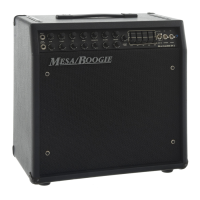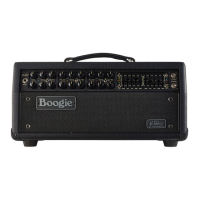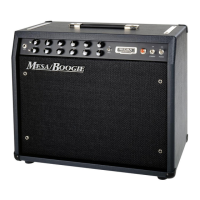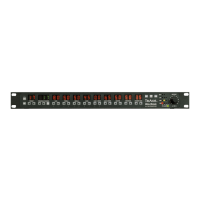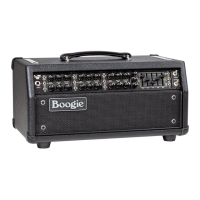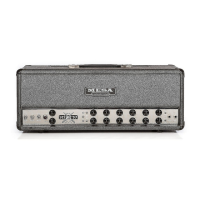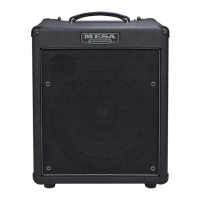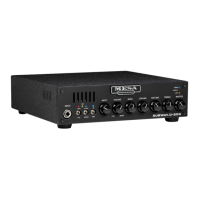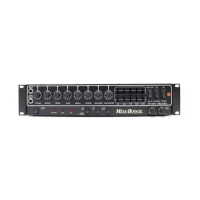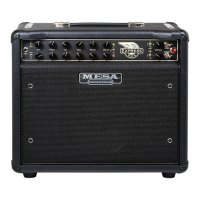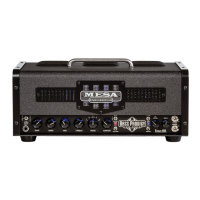The highest region of the GAIN control (2:00 – 5:00) is all about saturation. Up here the signal gets much fatter in the low end and the
top end begins to recede to create a rounder, more compressed sound. Dynamics become a little slower with lower peaks that are
smoothed a bit and a more liquid feel is produced. The highest region of the GAIN control produces some great pushed sounds as the
Input stage gives it up and starts to saturate. This range of the GAIN control turns this traditional “Clean circuit” into a viable and very
expressive vintage-inspired single note Soloing sound. With an already thicker base of gain , the upper region also accommodates
diode and tube based overdrive pedals nicely as they increase saturation and/or signal strength at the INPUT.
You may be a bit surprised how wonderfully aggressive the top end of the GAIN control can be on this ’traditional amp”, unveiling its
true potential for Crunch Rhythm and even Rock oriented soloing. There is ample gain up here to rip into any style you wish, save
for perhaps Modern Metal, pumping out surprisingly thick stacked harmonic layers for chording and/or very expressive and nuanced
overdrive for single notes.
At the highest GAIN settings you may notice the Tone controls have a slightly diminished effect on the sound. This is because the notes
are becoming so saturated and their character has been pre-determined by the circuit’s overall voicing as it reacts to this level of gain.
NOTE: TONE CONTROLS; In the California Tweed, different and unique top end frequencies are found in the TREBLE, MID and
PRESENCE controls. We suggest becoming familiar with what each of these powerful controls bring out or bury in the mix in terms
of top end and learn to “swap the top” as you see fit for different styles, characters, responses and attack center-points. Spending
a little time early on with these three powerful Tone and “dynamic” controls will allow you to dial up sounds quickly and easily and
enhance your enjoyment of your amplifier.
TREBLE
While the GAIN is the most powerful control in the preamp, the TREBLE comes in a close second. The TREBLE is
largely responsible for shaping the character of the sound and response. It can overpower the rest of the Tone controls due to its
cut and slice component and therefore its setting is crucial to a rich and balanced sound. Setting the TREBLE with care and taste in
mind is critical for achieving a blend and assuring the Tone control string works harmoniously.
The middle region of the TREBLE delivers the best balance and creates sounds that are plenty bright enough but still rich and warm.
We suggest that you start with the TREBLE at 11:00 and adjust up or down slightly until the desired blend is achieved. However,
circuits emanating from this “other side” of the MESA Line and sharing Tweed-based DNA tend to favor TREBLE and PRESENCE
control settings on the lower side for sounds in the warmer domain. Depending on guitar woods, pickups and technique, don’t be
surprised if you find great sounds below 11:00, or even occasionally very low on the TREBLE and PRESENCE, with the MID’s broad
Q that carries substantial top end providing all the top end cut you’ll need for some sounds.
Higher gain sounds, especially for Single Note Soloing, beg for experimenting with the TREBLE and PRESENCE around 10:00 -11:00
and the MID around 9:00 - 10:30 for a rich creamy response that feels great on the strings and sounds soulful and pleasing. Adjust
up or down to taste, but you will likely find the most vocal and round attack characteristics down in this range, especially for Fender
Scale Instruments. Shorter Scale guitars like Gibsons and darker woods like Mahogany may require a little higher settings on these
three controls or a deviation in ratio between them for the best balance and harmonic content.
MID
The MID control brings in and out a broad band of midrange frequencies and – as we have mentioned earlier in the TREBLE
section – along with these rides a fair amount of higher “low treble” range frequencies. These highs are lower than that of the TREBLE,
but they are important for the punch and cut of the amplifier in a mix.
For rhythm playing, but really globally, a lower MID setting (7:30–10:00) scoops some of this midrange attack and makes the bottom
end breathe more while letting the higher harmonics define the top end, producing more sparkle, chime and openness. This range
will also make things more resilient and create an easier to play, more elastic feel on the strings. Single coil guitars work very well
here for the slinky, rubber-band attack and bouncy bass character associated with Blues, R&B and Country or most any styles based
on clean response.
The middle region (10:00–1:00) is where the punch and attack begin to come on with more urgency and this is where mahogany
guitars really like to see the MID set for adding the cut and definition. Here the top end begins to show itself in the mix of the MID
PAGE 6
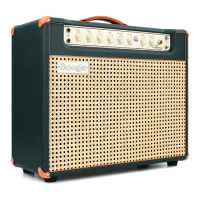
